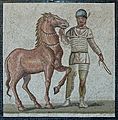Chariot racing facts for kids
Chariot races were a super popular and exciting sport in ancient times, especially in Ancient Greece and Rome. Imagine fast chariots pulled by powerful horses, racing around a huge track! It was a thrilling event for everyone watching.
These races were quite dangerous for both the drivers, called charioteers, and their horses. Accidents happened often, leading to serious injuries or even death. But strangely, these dangers made the races even more exciting for the crowds! Unlike many other ancient sports, women were allowed to watch chariot races, which made them even more popular.
In Roman chariot racing, teams were formed by different groups who paid for them, kind of like sponsors today. These teams would often compete to get the best and most skilled drivers to race for them.
Contents
What Were Chariot Races?
Chariot races involved chariots, which were small, two-wheeled carts, pulled by horses. Usually, two or four horses pulled a chariot. The goal was simple: be the first to cross the finish line after a set number of laps.
The Chariots and Horses
Chariots were usually made of wood and leather, making them light and fast. They were designed for speed, not comfort or safety. The charioteer stood in the chariot, holding the reins.
The horses were specially trained for racing. They were strong and quick. A team of four horses was called a quadriga, and a team of two was a biga.
Who Were the Charioteers?
Charioteers were the drivers of the chariots. They were often slaves or freedmen, but if they won, they could become incredibly famous and rich. They wore special helmets and protective gear, but racing was still very risky.
Where Did They Race?
Chariot races took place in large stadiums called circuses in Rome, or hippodromes in Greece. These venues were huge, designed to hold thousands of cheering fans.
The Circus Maximus
The most famous racing track was the Circus Maximus in Rome. It was an enormous stadium that could hold over 150,000 people! It had a long oval track with a dividing barrier down the middle called the spina.
The Hippodrome of Constantinople
Another famous track was the Hippodrome of Constantinople. This was built later, when the Roman Empire moved its capital to Constantinople (modern-day Istanbul). It was also a massive arena for races and public events.
How a Race Worked
A typical race involved several chariots, usually 7 or 12, starting at the same time. They would race for about seven laps around the track.
Starting the Race
Chariots would line up behind starting gates. When a signal was given, the gates would open, and the chariots would burst forward. The start was always chaotic and exciting!
The Track and Turns
The spina in the middle of the track had turning posts at each end, called metae. These turns were the most dangerous parts of the race. Charioteers would try to hug the inside of the turn to save distance, often leading to crashes.
Dangers and Crashes
Crashes were very common. Chariots could overturn, horses could fall, and charioteers could be dragged or trampled. The excitement for the crowd was often tied to these dramatic moments.
Teams and Factions
In Roman chariot racing, there were four main teams, or "factions," each known by a color:
- The Reds
- The Whites
- The Blues
- The Greens
Each team had its own fans, like modern sports teams. People would passionately support their favorite color. These factions were more than just sports teams; they sometimes had political influence too.
Betting and Fame
People would bet huge amounts of money on the races and their favorite teams. Winning charioteers became huge celebrities, earning lots of money and fame. Their names were known throughout the empire.
Images for kids
-
Modern depiction (1876) by Jean Léon Gérôme of a chariot race in Rome's Circus Maximus, as if seen from the starting gate. The Palatine Hill and Imperial palace are to the left
-
The Charioteer of Delphi, an anonymous charioteer who probably drove in the Pythian Games for Polyzalus, tyrant of Gela, in Sicily (480-470BC)
-
A plan of the Circus Maximus. The starting gates are to the left, and a conjectured start-line cuts across the track, to the right of the nearest meta.
-
Bas-relief of a quadriga race in the Circus Maximus (2nd–3rd century)
-
Chariot race of Cupids; ancient Roman sarcophagus in the Museo Archeologico (Naples). Brooklyn Museum Archives, Goodyear Archival Collection
-
A charioteer of the White team; part of a mosaic of the third century AD, showing four leading charioteers from the different colors, all in their distinctive gear
-
Mosaic from Lyon illustrating a chariot race with the four factions: Blue, Green, Red and White
-
The Hippodrome of Constantinople in Istanbul is more or less levelled, apart from some structures on the spina. The Walled Obelisk in the foreground and Thutmose's Obelisk is on the right
-
The Triumphal Quadriga is a set of Roman or Greek bronze statues of four horses, originally part of a monument depicting a quadriga. They date from late Classical Antiquity and were long displayed at the Hippodrome of Constantinople. In 1204 AD, Doge Enrico Dandolo sent them to Venice as part of the loot sacked from Constantinople in the Fourth Crusade.
See also
 In Spanish: Carreras de carros para niños
In Spanish: Carreras de carros para niños














